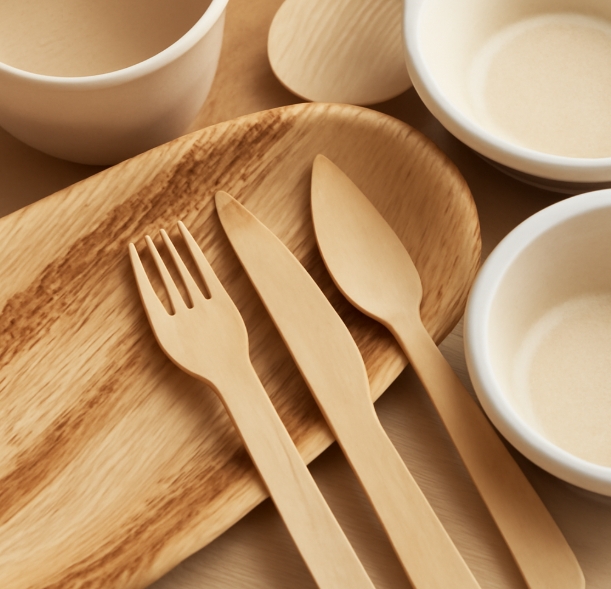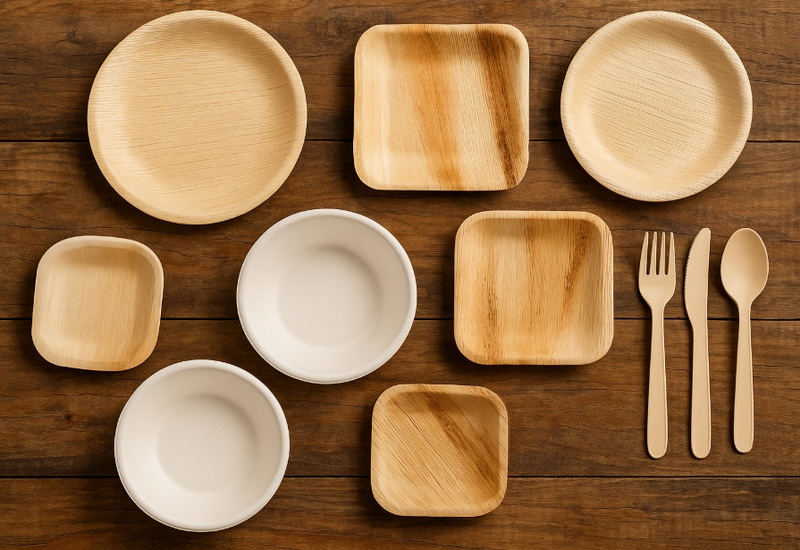
Content Menu
● Understanding Sustainable Disposable Tableware
>> What Is Sustainable Disposable Tableware?
>> Common Materials Used
● Why Replace Plastic Tableware?
>> Environmental Impact of Plastic Tableware
>> The Rise of Sustainable Alternatives
● The Advantages of Sustainable Disposable Tableware
>> Reduces Plastic Pollution
>> Made from Renewable Resources
>> Compostable and Biodegradable
>> Lower Carbon Footprint
>> Stylish and Versatile
● Challenges and Considerations
>> Durability and Performance
>> Composting Infrastructure
>> Cost Comparison
>> Certifications and Standards
● How to Host a Sustainable Party
>> Choose Certified Sustainable Disposable Tableware
>> Plan for Proper Disposal
>> Minimize Single-Use Items
>> Educate Your Guests
>> Get Creative with Decor
>> Choose Local and Seasonal Foods
● Comparing Tableware Options
● Sustainable Disposable Tableware in Action
● The Future of Sustainable Tableware
● Conclusion
● FAQ: Sustainable Disposable Tableware
>> 1. What materials are commonly used in sustainable disposable tableware?
>> 2. How do I dispose of sustainable disposable tableware after my party?
>> 3. Is sustainable disposable tableware as durable as plastic?
>> 4. Does using sustainable disposable tableware really make a difference?
>> 5. Are there certifications to look for when buying sustainable disposable tableware?
Planning a party today is no longer just about food, music, and decorations—it's also about making choices that reflect your values and care for the environment. The shift from traditional plastic tableware to sustainable disposable tableware is gaining momentum, but can these eco-friendly alternatives truly replace plastic at your next gathering? This in-depth guide explores the world of sustainable disposable tableware, its benefits, challenges, and practical tips for hosting a greener celebration.

Understanding Sustainable Disposable Tableware
What Is Sustainable Disposable Tableware?
Sustainable disposable tableware refers to single-use plates, cups, utensils, and napkins made from renewable, biodegradable, or compostable materials. Unlike conventional plastic, which lingers in landfills and oceans for centuries, these alternatives are designed to break down naturally, minimizing environmental harm.
Common Materials Used
- Bamboo: Fast-growing, renewable, and naturally pest-resistant, bamboo is a popular choice for sturdy, heat-tolerant plates and cutlery.
- Palm Leaves: Fallen palm leaves are pressed into elegant, rustic plates that biodegrade quickly.
- Sugarcane Bagasse: A byproduct of sugar production, bagasse is molded into durable, compostable plates and bowls.
- Wheat Straw: Agricultural residue from wheat processing, wheat straw is lightweight and compostable.
- Cornstarch: Used to create plant-based plastics (PLA), cornstarch tableware mimics the look and feel of traditional plastic but is compostable.
Why Replace Plastic Tableware?
Environmental Impact of Plastic Tableware
Plastic tableware is convenient but comes at a significant environmental cost. It takes centuries to decompose, pollutes waterways, and harms wildlife. Most single-use plastics are not recycled and end up in landfills or incinerators, contributing to greenhouse gas emissions and toxic pollution.
The Rise of Sustainable Alternatives
Sustainable disposable tableware offers a solution by using materials that are renewable and designed to return to the earth safely. These alternatives reduce plastic pollution, lower carbon footprints, and support a circular economy where waste becomes a resource rather than a problem.
The Advantages of Sustainable Disposable Tableware
Reduces Plastic Pollution
Switching to sustainable disposable tableware directly cuts down on the plastic waste generated at parties and events. Biodegradable and compostable options break down naturally, helping to keep landfills and oceans cleaner.
Made from Renewable Resources
Materials like bamboo, palm leaves, and sugarcane are rapidly renewable, meaning they can be regrown or replenished much faster than fossil fuels used in plastic production.
Compostable and Biodegradable
Many sustainable disposable tableware products are certified compostable, meaning they break down into nutrient-rich compost in industrial or home composting settings. This process returns valuable organic matter to the soil without leaving toxic residues.
Lower Carbon Footprint
The production of sustainable tableware generally uses less energy and produces fewer greenhouse gases compared to plastic manufacturing. Bamboo, for example, requires minimal water and no pesticides, further reducing its environmental impact.
Stylish and Versatile
Eco-friendly tableware often boasts unique aesthetics—from the natural grain of bamboo to the rustic charm of palm leaves—elevating the look of your party while being gentle on the planet.
Challenges and Considerations
Durability and Performance
While sustainable disposable tableware has improved in quality, some options (like plant fiber or wheat straw) may be less sturdy than plastic, especially with heavy or very wet foods. Bamboo and palm leaf plates, however, are known for their strength and heat resistance.
Composting Infrastructure
Not all communities have access to industrial composting facilities. Some compostable products require specific conditions to break down efficiently, so proper disposal is key to realizing their environmental benefits.
Cost Comparison
Eco-friendly alternatives often cost more than plastic due to higher material and manufacturing expenses. However, as demand increases and technology advances, prices are gradually becoming more competitive.
Certifications and Standards
Look for certifications such as compostable, biodegradable, or food-safe labels to ensure the tableware meets recognized environmental and safety standards. These certifications help consumers make informed, trustworthy choices.

How to Host a Sustainable Party
Choose Certified Sustainable Disposable Tableware
Opt for products made from bamboo, palm leaves, sugarcane bagasse, or certified compostable materials. Check for third-party certifications to verify claims.
Plan for Proper Disposal
Set up clearly labeled bins for compostables, recyclables, and landfill waste. If possible, partner with local composting services or encourage guests to take compostables home.
Minimize Single-Use Items
Consider mixing sustainable disposable tableware with reusable options, such as glassware or stainless steel cutlery, especially for smaller gatherings.
Educate Your Guests
Let guests know about your eco-friendly choices and how they can help by sorting their waste correctly. This not only reduces contamination but also raises awareness about sustainable practices.
Get Creative with Decor
Use reusable or compostable decorations, such as cloth napkins, potted plants, or banners made from recycled paper. Avoid balloons and plastic confetti.
Choose Local and Seasonal Foods
Reduce your event's carbon footprint further by serving locally sourced, seasonal dishes. This supports local farmers and minimizes transportation emissions.
Comparing Tableware Options
| Material | Biodegradability | Durability | Heat Resistance | Compostable | Aesthetic Appeal |
| Bamboo | High | High | Medium | Yes | Natural, Modern |
| Palm Leaf | Very High | Medium | High | Yes | Rustic, Unique |
| Sugarcane Bagasse | High | Medium | Medium | Yes | Neutral, Clean |
| Wheat Straw | High | Medium | Low | Yes | Light, Simple |
| Cornstarch (PLA) | High | Medium | Medium | Yes | Plastic-like |
| Plastic | None | High | High | No | Standard |
Sustainable Disposable Tableware in Action
Imagine a summer garden party: tables set with elegant bamboo plates, palm leaf serving trays, and compostable cutlery. Guests enjoy their meals, and at the end of the night, everything goes into a compost bin—no plastic waste, no guilt. This scenario is increasingly achievable as sustainable disposable tableware becomes more accessible and affordable.
The Future of Sustainable Tableware
As consumer demand grows and regulations tighten around single-use plastics, the market for sustainable disposable tableware is set to expand. Innovations in materials, manufacturing, and composting infrastructure will continue to improve performance and affordability. The ultimate goal is a zero-waste event where every item used can return safely to the earth.
Conclusion
Sustainable disposable tableware offers a practical, stylish, and environmentally responsible alternative to plastic at your next party. While there are challenges—such as cost, composting infrastructure, and durability—ongoing innovation and increasing awareness are making it easier than ever to host eco-friendly events. By choosing certified sustainable products, planning for proper disposal, and educating your guests, you can significantly reduce your party's environmental footprint without sacrificing convenience or style.

FAQ: Sustainable Disposable Tableware
1. What materials are commonly used in sustainable disposable tableware?
Sustainable disposable tableware is typically made from bamboo, palm leaves, sugarcane bagasse, wheat straw, and cornstarch-based bioplastics. These materials are renewable, biodegradable, and often compostable, making them excellent alternatives to plastic.
2. How do I dispose of sustainable disposable tableware after my party?
Most sustainable disposable tableware can be composted in industrial composting facilities. Some options, like bamboo and palm leaf, may also break down in home composting systems. Always check the product's disposal instructions and local composting guidelines.
3. Is sustainable disposable tableware as durable as plastic?
Bamboo and palm leaf plates are known for their strength and heat resistance, making them suitable for most party foods. Other materials, like wheat straw or bagasse, may be less sturdy with very heavy or wet foods but are generally reliable for typical party use.
4. Does using sustainable disposable tableware really make a difference?
Yes, switching to sustainable disposable tableware reduces plastic pollution, supports renewable agriculture, and lowers your event's carbon footprint. When composted properly, these products return nutrients to the soil instead of lingering in landfills.
5. Are there certifications to look for when buying sustainable disposable tableware?
Look for certifications such as compostable, biodegradable, or food-safe labels from recognized organizations. These ensure the products meet environmental and safety standards, giving you confidence in your eco-friendly choice.

















